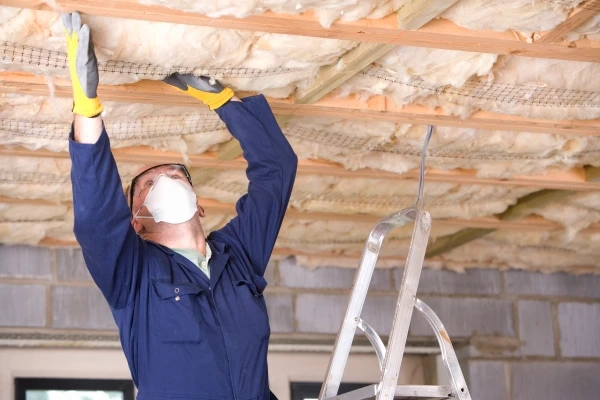
Aire Serv experts explain why insulating your basement ceiling and walls can improve energy efficiency and comfort.
- Assess moisture issues before starting insulation.
- Choose appropriate insulation materials for walls and ceilings.
- Install a vapor barrier to prevent dampness.
- Seal gaps and cracks for maximum efficiency.
- Finish with drywall or paneling for protection.
If you live in a home with an unfinished basement, you may have given some thought to the idea of renovating it to create a more usable, efficient space. However, you may be wondering if the time, effort, and cost to do so is worth it.
The fact is, an unfinished, uninsulated basement can significantly decrease your home’s efficiency and value. Just investing in basement insulation can increase your home’s efficiency, reduce stress on your HVAC system, and make your home more comfortable throughout the year.
Since there are several insulation options to choose from, and you may want to tie your insulation project into other home upgrades, including weatherproofing, we will review some of the choices to help you decide the best one for you.
Will Insulating a Basement Make the House Warmer?
A well-insulated home can help make it both warmer and cooler, depending on the season. During the summer months, insulation will help keep cool air in. During cooler months, better insulation will help keep your home warmer, which should also help lower your energy cost.
Choosing the best way to insulate your home will depend on the design of your basement and your goals. Here are a few other things to consider; access to utilities (maintain access to HVAC vents), the condition of the basement, and the primary and secondary uses of your basement space.
Related Topic: How to Insulate Ductwork
Should I Insulate My Basement Walls?
Yes—in most cases insulating your basement is a good idea because it will pay dividends down the road. Not only does wall insulation help keep your home warmer but it may also help soundproof the space. Many homeowners choose to “finish” their basement at the time of insulation, making it more efficient, aesthetically pleasing, and functional all at once.
You can begin to see real savings when you insulate your exposed foundation walls. Insulating foundation walls will help keep the cold air out during harsh winter months.
Remember, however, that “insulated” does not mean sealed or “weatherproofed.” If your basement floods or if water has seeped through the walls previously then these issues will need to be addressed prior to or during your insulation project. Once a basement is insulated and/or finished, check for any signs of water damage. You should also monitor the inside humidity periodically. High humidity can be the result of dampness caused by a leak or moisture coming in from an outside source.
Should I Insulate My Basement Ceiling?
Maybe. Insulating a basement ceiling will make the floor above, the traditional first floor of your home, feel warmer. In return, the basement will be cooler because the insulation will trap the warm air above and the cool air below.
If you plan to use your basement as a living space, this issue (a cool basement) can be addressed by installing ductwork and vents that direct warm air to the area. Or you can choose not to insulate the basement ceiling.
However, if you do decide to insulate your ceiling, make sure any exposed pipes are insulated as well. This will protect them against freezing weather.
Should I Insulate My Basement Floor?
If you live in an older home located in a colder climate that gets four to five months of wintry weather than insulating your basement floor will make it warmer and more comfortable—ideal if you are using your basement as a living space.
odern homes with concrete foundations are usually insulated at the time of construction. However, if you are looking to make the space warmer during the winter you can add an insulated subfloor, with a finished floor (carpet, composite, etc.) on top. This added insulation will provide additional warmth and comfort over the winter.
How to Insulate Basement Walls, Floors, And Ceilings:
When it comes to insulation, you have options there too. Each type of insulation has its own benefits, and depending on your needs, a skilled professional can help you make the right choice for your home.
Three common types of insulation are:
- Sprayed foam insulation: Spray foam insulation is applied with some type of sprayer and is typically used to insulate walls and ceilings. This type of insulation and application does well for filling in gaps in and around walls and ceiling. Soon after it is applied it hardens, forming an effective weather barrier.
- Foam boards: Foam board insulation is an easy-to-work-with material that reduces heat transfer through structural elements like wood and steel studs. This rigid form of insulation varies in thickness and can be used on basement walls, floors, and ceiling.
- Fiberglass batting: This common type of insulation is made using fiberglass that is woven with other material to create a fantastic insulating product. This insulation is available in both sheets and large rolls (for bigger jobs) and is great for insulating between walls and in ceilings.
Related Topic: How to Insulate a Garage in 7 Easy Steps
What Is a Good R-value for Basement Insulation?
R-value is a term used in reference to the effectiveness of different types of insulation. The R-value refers to the resistance to heat flow through a particular material. The higher the R-value, the more effect the material is at insulating, and reduced heat loss. Your local HVAC professional can help you review the local building codes for R-value recommendations and regulations in your area.
What Else Can I Do to Keep My Home and Basement Warmer?
Installing insulation is one way to keep your home and basement more comfortable throughout the year. If you’re interested in some other ways to reduce energy usage, consider these steps:
- Use a smart thermostat to improve temperature setting efficiency
- Seal all windows and doors to reduce drafts
- Install thermopane curtains on all windows
- Install ceiling fans and adjust air flow based on the season
Include Basement Insulation in Your HVAC Plans
No matter how effective your HVAC system is, a poorly insulated home will be difficult to keep warm and cool year-round. Insulating your home properly is an effective way to improve the efficiency of your HVAC system, reduce energy cost and maintain your home at a comfortable temperature setting throughout the year.
If you have questions about how insulating your home can improve HVAC efficiency and lower energy cost, call your local Aire Serv pro or request an estimate online.
This article is intended for general informational purposes only and may not be applicable to every situation. You are responsible for determining the proper course of action for your home and property. Aire Serv is not responsible for any damages that occur as a result of this blog content or your actions. For the most accurate guidance, contact the Aire Serv location nearest you for a comprehensive, on-site assessment.
FAQs About Installing Insulation in a Basement
As an industry leader and a brand that is trusted by homeowners and businesses nationwide for our knowledge and experience, we’re happy to answer your HVAC questions. Here are answers to some of the frequently asked questions about installing insulation in a basement.
How do you insulate a basement?
Here's a step-by-step guide on how to insulate an unfinished basement:
- Identify the type of foundation: Determine if you have poured concrete, concrete block, or a combination. This will influence the best insulation method.
- Address moisture issues: Before insulating, fix any leaks or sources of dampness. Consider installing a vapor barrier on the warm side of the insulation in some cases, but consult local building codes, as an improper vapor barrier can trap moisture.
- Choose your insulation material: Common options include rigid foam board (XPS, EPS, or polyiso), fiberglass batts, or spray foam. Rigid foam is often preferred for basement walls due to its resistance to moisture.
- Measure and cut insulation: Carefully measure the wall areas you want to insulate and cut the insulation material to fit.
- Install the insulation:
- Rigid foam: Adhere the foam boards directly to the foundation walls using construction adhesive. Seal the seams with foil tape. Consider mechanical fasteners for added support, especially for thicker boards.
- Fiberglass batts: Install between wall studs (if you're framing walls). Ensure a snug fit without compression. A vapor barrier might be needed depending on your local climate and building codes.
- Spray foam: This is typically professionally installed and creates an airtight seal.
- Cover the insulation (optional but recommended): For rigid foam, a thermal barrier like drywall is often required by code for fire safety. For fiberglass, drywall provides a finished look.
Remember to consult local building codes regarding basement insulation requirements and vapor barriers.
Does a basement need to be insulated?
Yes, insulating your basement is highly recommended for several reasons. Insulation helps regulate the temperature, making your basement more comfortable and usable as a living space. Uninsulated basement walls can be a significant source of heat loss in the winter, leading to higher heating bills and cold floors upstairs. Conversely, in the summer, a lack of insulation allows cool air to escape, which increases cooling costs and may contribute to condensation and moisture problems.
Basement ceiling insulation can also help prevent drafts and reduce noise transfer. While not always strictly required by code for unfinished basements, the energy savings and comfort benefits make basement insulation a worthwhile investment.
Of course, the basement isn’t the only part of your home that needs insulation. Insulating your attic provides many benefits as well!
Why should you not insulate your basement?
While insulating basements offers numerous benefits, there are a few specific scenarios where it might be less critical or even potentially problematic. If your basement is entirely unconditioned (meaning it's essentially outdoors) and you use it only for storing items that are unaffected by temperature fluctuations, the immediate energy savings in the living areas above might be minimal.
However, even in this case, insulation can still offer benefits, such as preventing frozen pipes and reducing extreme temperature swings. The main reason not to insulate would be if there are significant, unresolved moisture issues. Insulating a damp basement without addressing the water intrusion can trap moisture against the foundation walls, potentially leading to mold growth and structural damage over time. Addressing the moisture problem should always be the priority before considering insulation.
If you believe your HVAC system may have an issue related to the moisture in your basement, contact a professional right away. Regular maintenance with an Aire Serv Advantage Plan Membership can offer you peace of mind.
Do you need to insulate basement walls?
Yes, insulating basement walls is generally recommended. Insulation helps regulate temperature by reducing heat loss in winter and heat gain in summer, leading to energy savings. Insulation also improves comfort, prevents drafts, and can help manage moisture when done correctly. While not always mandated, it's a smart choice for energy efficiency and a more comfortable home.
What kind of insulation for a basement ceiling?
Fiberglass batts are a common and budget-friendly choice for basement ceiling insulation, particularly when insulating basement ceiling joists. Mineral wool batts offer similar thermal performance and superior sound dampening, which can be beneficial for reducing noise transfer to the floor above.
Rigid foam board provides good insulation and moisture resistance and makes a good option if you plan to finish the ceiling with drywall. For more challenging spaces or to create an excellent air seal, consider spray foam insulation for a basement ceiling. Foam is a premium option, although it is typically more expensive.
What R-value is best for basement ceiling insulation?
For basement ceiling insulation, the recommended R-value depends on whether the basement is conditioned (heated or cooled) or unconditioned.
If you're insulating the space between an unconditioned basement and the living area, aim for an R-value of R-30 to R-60 for optimal energy efficiency and comfort in the rooms above. This helps prevent heat loss in winter and heat gain in summer.
If the basement is conditioned, the insulation primarily helps with sound damping and maintaining a consistent temperature within the basement. In this case, a lower R-value, such as R-19 to R-30, may be sufficient.
Local building codes may also specify minimum R-values, so check for compliance. Factors like your budget and the type of insulation you choose will also influence the final R-value you select.
Should I insulate a basement fireplace?
Insulating a basement fireplace requires careful consideration. The fireplace itself, especially the firebox and chimney, should not be insulated with combustible materials due to fire safety risks. Proper clearances for combustible materials are essential and mandated by building codes.
However, you can and often should insulate the exterior walls around the fireplace in the basement to improve overall energy efficiency and comfort. This helps prevent heat loss through the foundation walls surrounding the fireplace structure.
Use appropriate insulation materials for basement walls, like rigid foam board, while maintaining the necessary clearances from the fireplace itself. Always consult local building codes and manufacturer instructions for safe installation practices around fireplaces.

